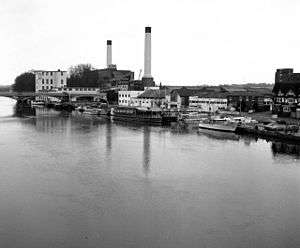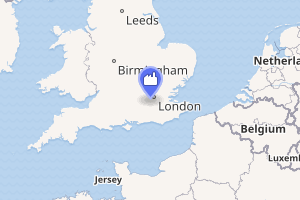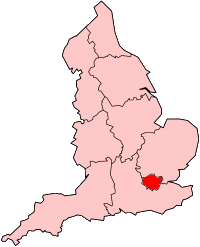Kingston Power Station, London
Kingston Power Station was a coal-fired generating station on the Thames in Kingston upon Thames, Surrey (later Greater London). It ceased generating in 1980 and has been demolished.
| Kingston Power Station, London | |
|---|---|
 Kingston Power Station from the south-west in 1982 | |

| |
| Country | England |
| Location | Greater London |
| Coordinates | 51.415400°N 0.306100°W |
| Status | Decommissioned |
| Commission date | 1893, 1948 |
| Decommission date | 1980 |
| Owner(s) | As operator |
| Operator(s) | British Electricity Authority (1948-55), Central Electricity Authority (1955-57), Central Electricity Generating Board (1958-81) |
| Thermal power station | |
| Primary fuel | Coal |
| Chimneys | 2 (215 ft) |
| Cooling towers | None |
| Cooling source | River water |
| Power generation | |
| Units operational | 4 × 30 MW |
| Units decommissioned | All |
| Nameplate capacity | 117 MW |
| Annual net output | See text |
| External links | |
| Commons | Related media on Commons |
grid reference TQ17936989 | |
History
The first station was built in 1893, with an original capacity of 225 kW. New generating equipment was added as the demand for electricity increased. The generating capacity, maximum load, and electricity generated and sold was as follows:[1]
| Year | Generating capacity, MW | Maximum load, MW | Electricity generated, GWh | Electricity sold, GWh |
| 1912/3 | 0.860 | 0.670 | 1.332 | 1.152 |
| 1918/9 | 2.00 | 0.95 | 2.175 | 1.608 |
| 1919/20 | 2.00 | 1.25 | 2.208 | 1.848 |
| 1923/4 | 4.50 | 2.00 | 4.081 | 2.394 |
| 1936/7 | 11.75 | 7.293 | None (30.711 purchased) | 19.140 |
The A station eventually closed in 1959. A new 'B' station was planned before World War II, opening in 1948. The Thames was used both for coal supply and ash removal, and as a source of cooling water.[2] The new station was the first to be opened following nationalisation of the power industry, with the official opening by King George VI, the first station to receive such an honour since Barking in 1924.[3]
Technical Specification
In 1923 the plant comprised two 1,250 kW turbo-alternators, these were supplied from the boiler plant which produced a total of 66,000 lb/hr (8.32 kg/s) of steam.[4] Electricity was available at 3-phase AC, 50 Hz at 440, 415 & 240V and single phase AC, 77 Hz at 210 & 105V. In 1923 the station generated 3.448 GWh of electricity, some of this was used in the plant, the total amount sold was 1.888 GWh. The revenue from sales of current was £39,623, this gave a surplus of revenue over expenses of £21,124.[4]
By 1966 Kingston B power station had 4 × 30 MW British Thomson-Houston turbo-alternators, giving a generating capacity of 123 MW.[5][6] The chain grate stoker Stirling boilers had a steam capacity of 1,710,000 lb/hr (215.4 kg/s). The steam conditions at the turbine stop valve were 600 psi (41.4 bar) and 454°C. The overall thermal efficiency of the station in 1966 was 21.12 per cent.[5]
Electricity output from Kingston power station was as follows.[5][6][7]
Kingston annual electricity output GWh.

Closure
Generation ceased on 27 October 1980 with a generating capacity of 117 megawatts.[8] The station was eventually demolished, despite calls for preservation as a power museum. The two 250-foot chimneys were demolished in 1994.[2]
See also
References
- London County Council. London Statistics (various dates). London: London County Council.
- Bob Carr. "Richmond and Kingston". Newsletter December 1994. Greater London Industrial Archaeology Society. Retrieved 18 April 2009.
- Bob Carr. "Richmond and Kingston". Newsletter April 1995. Greater London Industrial Archaeology Society. Retrieved 18 April 2009.
- Electricity Commission (1925). Electricity Supply - 1920-1923. London: HMSO. pp. 50–53, 290–95.
- CEGB Statistical Yearbook (various years). CEGB, London.
- Garrett, Frederick C. (ed) (1959). Garcke's Manual of Electricity Supply vol. 56. London: Electrical Press. pp. A-68, A-125.CS1 maint: extra text: authors list (link)
- GEGB Annual report and accounts, various years
- Mr. Redmond (16 January 1984). "Coal-fired Power Stations". Hansard. Retrieved 1 September 2009.
| Wikimedia Commons has media related to Kingston Power Station, London. |
